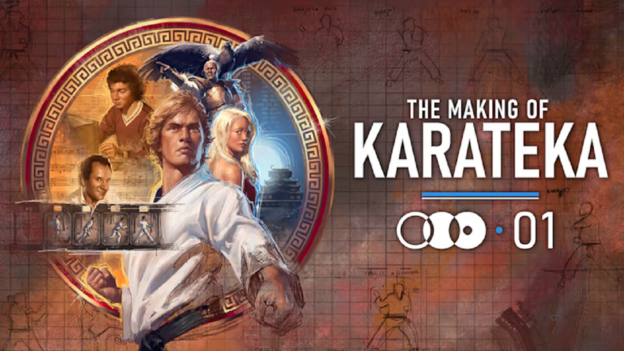The Making of Karateka (Nintendo Switch)

The Making of Karateka is a fascinating release I didn’t know I needed. It adopts the interactive timeline approach seen in Digital Eclipse’s Atari 50: The Anniversary Celebration, an acclaimed favorite from critics and fans everywhere. As the first release in their “Gold Master Series,” this title is aptly monikered. While its belt is black, its effort is gold medal-worthy.
Firstly, it must be recognized that those coming from Atari 50 should expect something different from 100-plus games here. But, despite the name, you’re not just paying for a single game alone. Instead, the focus is on one developer, Jordan Mechner, and his earliest works. While it really boils down to three games, thanks to the various prototypes, there are over a dozen total. Instead, the focus is on one developer, Jordan Mechner, and his earliest works. While it really boils down to three games, thanks to the various prototypes, there are over a dozen total.
The titular Karateka is the star. To players of a certain generation, this game needs no introduction. To younger players (or older ones who played mainly on consoles), Karateka is a cinematic martial arts adventure. Alongside games like Kung Fu Master, it signaled a boom in martial arts games throughout the remainder of the ’80s. Unlike Kung Fu Master from the arcade, this home game had far greater depth. Fights focused on observation, patience, and timing. Ahead of its time, it paved the way for Mechner’s later work, the cinematic platformer Prince of Persia.
There are seven versions of Kareteka packed in here, including three retail releases, three prototypes, and a remastered version. I enjoyed checking out the Apple II original, as it ran on a machine made before I was born. It also made me appreciate how good Karateka looked on aging hardware; it was already over seven years old at the time of release. I beat the game on the musically superior C64, with an enhanced framerate enabled as a bonus. The Atari 8-bit version looks the best in motion and plays quicker, but despite the option for play, it sometimes gets stuck in watch mode only—a curious bug. While this is one of a few glitches I’ve found, none are enough to detract in a significant way.
The highlight of this package is the remastered version, which plays with movement only dreamt of in 1984. The visuals are faithfully updated, and Francis Mechner’s original music is adapted in a way that really strikes a chord. An early idea (animated, but cut) has been restored. Having a goal list is such a thoughtful new replay incentive. The option for multiple lives is a wise choice that eliminates the need for a rewind option in this version, making the game feel much less dated. In truth, even in 1984, one life only felt dated. While the cushion of lives brought welcomed peace of mind, I eventually beat the game in a single run, on target with the original.
I feel compelled to be tougher on this newest version, as Digital Eclipse has raised the bar. While I commend the editorial director for pushing optional lives, he unwisely suggested leaving bodies piled up to represent where you failed. The team might find it a “hilarious… positive,” but it results in yanking you out of the game’s cinematic nature. Also, there’s an issue of lighting, which gets a fair amount of talk in the interesting (though clumsily implemented) commentary. A prime idea in theory, but single torch rooms become too dark, at least when played in handheld mode.
My biggest issue is the glitches surrounding the goal list. More than once, an alert appeared telling me a goal had been achieved, but it failed to check off. My total shows a completion percentage in the mid-60s instead of the high-70s, where it should be. Again, this release has a few glitches (at least on Switch) that need examining.
The other highlight is Deathbounce: Rebounded. Curiously, this one never went through the naming varieties that so many other Mechner creations did, and maybe it should have. Seeing the early ’80s conceptual prototypes (four early builds of various progress) given modern sensibilities makes this a fun twin-stick shooter with an arcade flair. I’ve enjoyed this enough that I believe it could be a standalone release.
You can lose hours in the timeline perusing old documents and screenshots, watching videos, and more, learning all sorts of things. I didn’t know Mechner’s original name for the baddies was Kratang; I regret that Broderbund changed it to the less original Akuma. I never realized the pronunciation of this title was so divisive, with multiple ideas and evidently no right or wrong answer. I appreciate the music of Francis Mechner even more now, and seeing the videos of him and Jordan reminiscing made me smile time and again.
But yet again, I feel the need to be a bit tougher on this timeline, given the excellence of the Atari 50 collection. While I appreciate how candid the former was, Karateka never quite reaches the same highs. While the briefest mention of the Famicom and Game Boy ports is added, the Atari 7800 port gets skipped entirely. I understand the latter might be embarrassing, with its poor audio, controls, and cut content. But as a console-only gamer, it was the version I was most familiar with. I wish the timeline had been all-encompassing, but glossing over or hiding outright some history makes the package feel slightly incomplete and a tad negligent.
Despite a few bugs and oversights, The Making of Karateka has become one of my favorite releases in 2023 and should be considered unmissable. Playing this interactive documentary, packed with history and fun remastered works, can’t help but make one wonder what Digital Eclipse plans next. How about a deep dive into Mechner’s later work, The Last Express?




